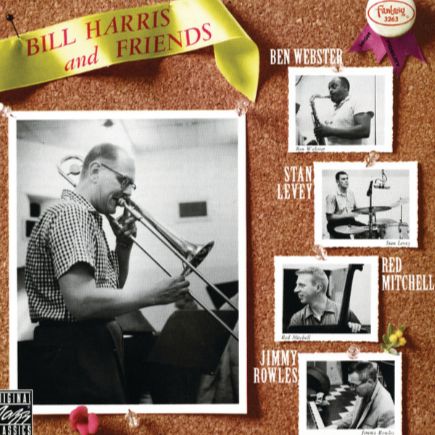Bill Harris, le trombone singulier du First Herd
Parmi les grands solistes du jazz de l’après-guerre, Bill Harris occupe une place à part. Tromboniste américain à la sonorité immédiatement identifiable, il a marqué l’histoire du jazz par un style expressif et audacieux, notamment au sein du First Herd, le big band de Woody Herman, dont il fut l’une des voix les plus marquantes.
Né à Philadelphie, Harris commence sa carrière dans les années 1930, alors que le swing domine les orchestres de danse. Très vite, il s’écarte du rôle traditionnel du trombone dans les big bands, souvent limité à des phrases amples et puissantes. Son jeu se distingue par un mélange rare de lyrisme et de vigueur percussive: il peut passer d’attaques incisives, presque saccadées, à des lignes d’une souplesse inattendue. Contrairement à Jack Teagarden, dont le style était profondément ancré dans le blues et le legato, Harris privilégie une articulation claire, tout en conservant une richesse mélodique. Cette dualité, entre swing mordant et élégance fluide, devient sa signature.
Le tournant de sa carrière survient en 1944 lorsqu’il rejoint Woody Herman. Le First Herd, orchestre audacieux et ouvert aux modernités du bebop, offre à Bill Harris un cadre idéal pour déployer son jeu. Ses interventions sur des enregistrements emblématiques comme Apple Honey révèlent une puissance collective transcendée par son timbre singulier. Mais c’est avec Bijou qu’il atteint son sommet artistique : cette pièce, considérée comme son chef-d’œuvre, met en valeur un phrasé aérien, une dynamique nuancée et une sonorité légèrement nasale qui confèrent au morceau une élégance inédite. Bijou devient son emblème, synthèse parfaite de force et de délicatesse.
Après la dissolution du First Herd en 1946, Harris poursuit une carrière de soliste très demandée. Il retrouve Herman à plusieurs reprises dans les années 1950, participe à de nombreux enregistrements et mène ses propres projets. Ses albums en leader confirment son approche singulière: plutôt que de se convertir radicalement au bebop, il en retient certains accents qu’il intègre à son swing d’origine, cultivant une modernité subtile sans rompre avec ses racines.
Bill Harris demeure l’un des rares trombonistes de son temps à avoir imposé une voix personnelle, capable d’élargir les possibilités expressives de l’instrument. Ni strictement swing, ni totalement bop, son jeu trace une voie singulière, où puissance et poésie se conjuguent avec une intensité rare.
Bill Harris, el trombón singular del First Herd
Entre los grandes solistas del jazz de la posguerra, Bill Harris ocupa un lugar aparte. Trombónista estadounidense de sonoridad inmediatamente reconocible, marcó la historia del jazz con un estilo expresivo y audaz, especialmente en el First Herd, la big band de Woody Herman, donde fue una de las voces más destacadas.
Nacido en Filadelfia, Harris inició su carrera en la década de 1930, cuando el swing dominaba las orquestas de baile. Muy pronto se apartó del rol tradicional del trombón en las big bands, a menudo limitado a frases amplias y poderosas. Su estilo se distinguía por una rara combinación de lirismo y vigor percusivo: podía pasar de ataques incisivos, casi entrecortados, a líneas de sorprendente flexibilidad. A diferencia de Jack Teagarden, cuyo estilo estaba profundamente anclado en el blues y el legato, Harris privilegiaba una articulación clara sin renunciar a la riqueza melódica. Esta dualidad, entre swing mordaz y elegancia fluida, se convirtió en su sello personal.
El gran giro de su carrera llegó en 1944, cuando Bill Harris se unió a Woody Herman. El First Herd, orquesta audaz y abierta a las modernidades del bebop, le ofreció un marco ideal para desplegar su juego. Sus intervenciones en grabaciones emblemáticas como Apple Honey revelan una fuerza colectiva exaltada por su timbre único. Pero fue con Bijou donde alcanzó su cima artística: esta pieza, considerada su obra maestra, exhibe un fraseo aéreo, una dinámica matizada y una sonoridad ligeramente nasal que le otorgan una elegancia inédita. Bijou se convirtió en su emblema, síntesis perfecta de fuerza y delicadeza.
Tras la disolución del First Herd en 1946, Harris continuó como solista muy solicitado. Volvió en varias ocasiones con Herman en los años cincuenta, participó en numerosas grabaciones y lideró sus propios proyectos. Sus álbumes como líder confirmaron su enfoque singular: en lugar de abrazar radicalmente el bebop, integró discretamente algunos de sus acentos, cultivando una modernidad sutil sin romper con sus raíces de swing.
Bill Harris sigue siendo uno de los pocos trombonistas de su tiempo que logró imponer una voz verdaderamente personal, capaz de ampliar las posibilidades expresivas del instrumento. Ni estrictamente swing ni totalmente bop, su estilo abrió un camino único, donde potencia y poesía se conjugan con una intensidad rara.
Bill Harris, il trombone singolare del First Herd
Tra i grandi solisti del jazz del dopoguerra, Bill Harris occupa una posizione a sé. Trombettista statunitense dalla sonorità immediatamente riconoscibile, ha segnato la storia del jazz con uno stile espressivo e audace, in particolare all’interno del First Herd, la big band di Woody Herman, di cui fu una delle voci più emblematiche.
Nato a Filadelfia, Harris iniziò la carriera negli anni Trenta, quando lo swing dominava le orchestre da ballo. Ben presto si allontanò dal ruolo tradizionale del trombone nelle big band, spesso confinato a frasi ampie e potenti. Il suo stile si distingueva per una rara combinazione di lirismo e vigore percussivo: sapeva passare da attacchi incisivi, quasi spezzati, a linee di sorprendente flessibilità. Diversamente da Jack Teagarden, il cui stile era profondamente radicato nel blues e nel legato, Harris privilegiava un’articolazione chiara senza rinunciare alla ricchezza melodica. Questa dualità, tra swing tagliente ed eleganza fluida, divenne la sua firma.
Il momento decisivo della sua carriera arrivò nel 1944, quando Bill Harris entrò nell’orchestra di Woody Herman. Il First Herd, formazione audace e aperta alle novità del bebop, offrì a Harris un contesto ideale per sviluppare il suo gioco. I suoi interventi in registrazioni emblematiche come Apple Honey rivelano una potenza collettiva esaltata dal suo timbro unico. Ma fu con Bijou che raggiunse il suo apice artistico: questo brano, considerato il suo capolavoro, mette in risalto un fraseggio aereo, una dinamica sfumata e una sonorità leggermente nasale che conferiscono al pezzo un’eleganza inedita. Bijou divenne il suo emblema, sintesi perfetta di forza e delicatezza.
Dopo lo scioglimento del First Herd nel 1946, Harris proseguì come solista molto richiesto. Tornò più volte con Herman negli anni Cinquanta, partecipò a numerose registrazioni e guidò propri progetti. I suoi album da leader confermarono il suo approccio singolare: invece di aderire radicalmente al bebop, ne integrò discretamente alcuni accenti, coltivando una modernità sottile senza rompere con le radici swing.
Bill Harris resta uno dei pochi trombonisti del suo tempo ad aver imposto una voce davvero personale, capace di ampliare le possibilità espressive dello strumento. Né puramente swing né completamente bop, il suo stile ha tracciato una via unica, in cui potenza e poesia si coniugano con un’intensità rara.
Bill Harris, the singular trombone of the first herd
Among the great postwar jazz soloists, Bill Harris holds a unique place. The American trombonist, with a sound instantly recognizable, left his mark on jazz history through an expressive and daring style, especially within Woody Herman’s First Herd, where he became one of the band’s most distinctive voices.
Born in Philadelphia, Harris began his career in the 1930s, when swing dominated the dance orchestras. Very quickly he moved away from the trombone’s traditional role in big bands, often confined to broad and powerful lines. His playing stood out for a rare mix of lyricism and percussive drive: he could shift from incisive, almost staccato attacks to unexpectedly supple lines. Unlike Jack Teagarden, whose style was rooted in blues and legato, Harris favored a crisp articulation while maintaining melodic richness. This duality—biting swing combined with fluid elegance—became his trademark.
The turning point of his career came in 1944, when Bill Harris joined Woody Herman. The First Herd, bold and open to the innovations of bebop, provided Harris with the perfect setting to expand his playing. His contributions to emblematic recordings such as Apple Honey revealed a collective energy magnified by his unique timbre. But it was with Bijou that he reached his artistic peak: this piece, considered his masterpiece, highlights his airy phrasing, nuanced dynamics, and slightly nasal tone, giving the music a previously unheard elegance. Bijou became his signature work, the perfect synthesis of power and delicacy.
After the First Herd dissolved in 1946, Harris pursued a highly sought-after career as a soloist. He rejoined Herman several times in the 1950s, took part in numerous recordings, and led his own projects. His albums as a leader confirmed his singular approach: rather than fully embracing bebop, he discreetly absorbed some of its accents, cultivating a subtle modernity while remaining faithful to his swing roots.
Bill Harris remains one of the few trombonists of his generation to have forged a truly personal voice, expanding the expressive possibilities of the instrument. Neither strictly swing nor fully bop, his style carved out a unique path, where power and poetry combine with rare intensity.


